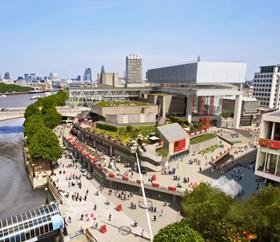Conservation body raises multiple concerns about revised planning application and refuses to withdraw opposition

English Heritage has dismissed Feilden Clegg Bradley Studios’ revised proposals for the Southbank Centre and refused to withdraw its opposition to the £120m scheme.
In a letter to Lambeth’s planning department, it warned of “serious and irreversible harm” and reiterated its objections to the controversial redevelopment on a number of grounds.
It said pulling back the “liner building” by three metres had not addressed concerns about the damage it would cause to views of the National Theatre or to the character of the South Bank, which it said was Britain’s “finest collection of post-war public buildings”.
It noted that Denys Lasdun’s grade II* design for the National Theatre was a direct response to the setting, which the architect described as “magical” and “probably the most beautiful site in London”.
In its letter, English Heritage said: “The setting of the National Theatre will be seriously and irreversibly harmed by eroding the ability to appreciate this key designed relationship with the river which is part of its architectural significance.”
It calls for the liner building to be substantially diminished and claims it fails to comply with the council’s own policy that “development which adversely affects the setting of a listed building or significant views of a listed building will be refused”.
English Heritage also objects to the elevated rehearsal room rising between the Hayward Gallery and Queen Elizabeth Hall. Its scale and mass would reduce the visual dominance of the theatre Olivier flytower, it said.
“The South Bank conservation area is an example of a post-war urban landscape as impressive and consistent as the Royal Hospital at Greenwich is as an English Baroque composition,” it adds.
“Both are arguably the finest British examples of their period and both would suffer from the insertion of unsympathetic modern development. New architecture in the context of the unique 20th-twentieth character and appearance of the South Bank should defer to rather than compete with the existing buildings, and this is not achieved by the proposed development.”
But EH does now concede there could be an argument for moving the skateboarders to Hungerford Bridge since a 2001 book by Iain Borden – the Bartlett professor advising the Southbank Centre – demonstrates that skating took place there historically.
English Heritage’s comments come as the Southbank Centre’s trustees review the entire redevelopment in the wake of Boris Johnson’s explosive decision to back the existing skatepark.
Management insist the viability of the refurbishment hinges on replacing the skate park with commercial units and challenged the mayor to plug the funding gap. The planning process has been delayed once while plans for a replacement skate area were developed.
They refused to be drawn on whether the revamped planning application will still be considered by Lambeth council next month as originally envisaged.



























No comments yet